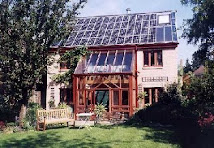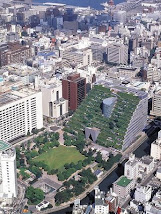Solar air heating system is a metal consisting of aluminum or steel cladding, that is installed on the south-facing wall of a building. The system operates in a very simple manner using economical and environmentally-benign solar energy to heat buildings. The dark-colored metal cladding is heated by solar radiation. Ventilation fans located at the top of the wall create a negative pressure in the cavity between the cladding and the building. Outside air is drawn through tiny holes in the Solarwall and is heated by the metal panels. Air rises in the cavity to a plenum at the top of the wall. The incoming warm air is ducted to the nearest fan. Warm, fresh air is distributed throughout the building.
 Bombardier's 100,000 ft2 (10,000 m2)
Bombardier's 100,000 ft2 (10,000 m2)Solarwall is the world's largest solar air heating system.
This unique solar system even reduces the loss of heat in winter by capturing the escaping air with incoming air and pushing it back into the building. This also remains true at night time when heat loss occurs as well.
In the summer, the Solarwall system works by preventing solar radiation from hitting the south side of the building. Hot air naturally rises so the hot air trapped between the wall and the Solarwall rises to the top of the building where it is vented out. Fresh, cool air is drawn in by dampers to keep the building cool. Because of the fresh air constantly entering the building, Solarwall increases the air quality and overall health conditions for the facility.
- operating efficiency of up to 75% rated by both the Canadian and US governments
- on a sunny day, the temperature can raise anywhere from 30° to 76° F (16° to 40° C) depending on flow rate
- the cost of this solar heating system when being constructed is usually less than the cost of a brick wall or even a metal-clad wall
- even on cloudy days, the Solarwall provides significant energy savings as a preheating system for ventilation air
- a typical installation produces 50 to 70 kwh/ft2 (500 to 700kWh/m2)
- energy savings of $1 to $6/ft2 ( $10 to $60/m2) during the heating season; if the Solarwall is utilized for process air heating, the savings are even greater
- the economic benefits according to the Federal Express distribution center in Colorado indicate that savings will be $12,000 US annually, and that 254,000 pounds (115,000 kilograms) of carbon dioxide emissions will not be released into the atmosphere
















